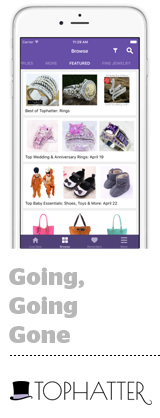
Back when real-time auction app Tophatter was founded in 2012, it spent as much as 95% of its user acquisition budget on Facebook.
But with a solid user base of around 12 million registered users, it’s been making a concerted effort to mix up its UA strategy.
“In the beginning, Facebook was a big gorilla, but it’s also a little risky to rely on one network for all of your traffic,” said Ragnar Gudmundsson, Tophatter’s VP of growth and marketing. “We have limited resources and we have a big initiative to diversify away from Facebook.”
Moving away from Facebook helps keep CPMs down by not “putting too much pressure on any one acquisition channel,” he said.
With Facebook “well under” half of Tophatter’s UA budget, the rest of its spend is distributed among a small number of larger mobile ad networks, including YouAppi, which Tophatter leverages to acquire profitable users based on internal KPIs, like cost for first purchase.
Tophatter doesn’t put a cap on the budget it sends to YouAppi, where it’s seen solid results on the cost for first purchase KPI.
For Gudmundsson and his team,to extract value from its paid UA efforts, they need to see newly acquired users to download and convert on day one. That’s also how it knows an acquisition source is working.
Tophatter, which also works with Google, Taboola and Outbrain on acquisition, monetizes in a similar manner to eBay – it gets a commission anytime something is sold on the platform – but the auctions go down at hyperspeed, taking 90 seconds from the first bid to the last.
“Over time, we’ve learned what to look for,” Gudmundsson said. “We know that most of our customers convert on the first day they register. We also know that their activity over the first three days following registration is a proxy for how long they’ll stay overall.”
Tophatter is aggressive with its paid efforts. The majority of its profits are immediately reinvested back into marketing. The quicker the payback, the faster Tophatter can put the money “back into the acquisition machine,” Gudmundsson said.
As Tophatter’s user acquisition strategy matures and Facebook has continued to recede as a traffic source, Tophatter is becoming increasingly selective in how it chooses its ad network partners.
In the early days, Tophatter was willing to test almost anyone that came along, which it why it ended up working with heaps of small ad networks, most of which had limited scale.
Now, Tophatter has a more rigorous process to put potential partners through their paces. Networks need to exhibit a proven track record of working at scale with other ecommerce clients, show how quickly they’re able to ramp up spend, explain how they optimize the traffic they send and demonstrate that they’ll be able to easily ingest Tophatter’s data.
“Of course, it’s not a perfect vetting process,” Gudmundsson said. “The reality is that we generally don’t end up using nine out of 10 partners we try out on a long-term basis. But we do need to keep actively testing. We’re looking for at least one or two successes each quarter with good scale.”
This post was syndicated from Ad Exchanger.

More Stories
Special campaigns ranked among world’s most effective
NZME honours outstanding finalist success across top media awards
L’Oréal partners with WPP for influencer growth